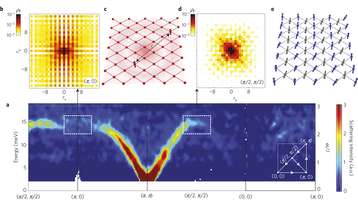How electrons split: New evidence of exotic behaviors

Electrons may be seen as small magnets that also carry a negative electrical charge. On a fundamental level, these two properties are indivisible. However, in certain materials where the electrons are constrained in a quasi one-dimensional world, they appear to split into a magnet and an electrical charge, which can move freely and independently of each other. A longstanding question has been whether or not similar phenomenon can happen in more than one dimension. A team lead by EPFL scientists now has uncovered new evidence showing that this can happen in quasi two-dimensional magnetic materials. Their work is published in Nature Physics.
A strange phenomenon occurs with electrons in materials that are so thin that they can be thought of as being one-dimensional, e.g. nanowires. Under certain conditions, the electrons in these materials can actually split into an electrical charge and a magnet, which are referred to as "fractional particles". An important but still unresolved question in fundamental particle physics is whether this phenomenon could arise and be observed in more dimensions, like two- or three-dimensional systems.
Henrik M. Rønnow and Bastien Dalla Piazza at EPFL and Martin Mourigal (recently appointed Assistant professor at Georgia Tech) have now led a study that provides both experimental and theoretical evidence showing that this exotic split of the electrons into fractional particles actually does take place in two dimensions. The scientists combined state-of-the-art polarized neutron scattering technology with a novel theoretical framework, and tested a material that normally acts as an electrical insulator. Their data showed that the electrons magnetic moment can split into two halves and move almost independently in the material.
The existence of fractional particles in more than one dimension was proposed by Nobel laureate PW Anderson in 1987 when trying to develop a theory that could explain high-temperature superconductivity: the ability of some materials to conduct electricity with zero resistance at very low, yet technologically feasible, temperatures. This phenomenon remains one of the greatest mysteries and has been extensively researched in the most promising high-temperature superconductors, the copper-containing cuprates.
Under temperatures close to absolute zero, electrons bind together to form an exotic liquid that can flow with exactly no friction. While this was previously observed at near-absolute zero temperatures in other materials, this electron liquid can form in cuprates at much higher temperatures that can be reached using liquid nitrogen alone. Consequently, there is currently an effort to find new materials displaying high-temperature superconductivity at room temperature. But understanding how it arises on a fundamental level has proven challenging, which limits the development of materials that can be used in applications. The advances brought by the EPFL scientists now bring support for the theory of superconductivity as postulated by Anderson.
"This work marks a new level of understanding in one of the most fundamental models in physics," says Henrik M. Rønnow. "It also lends new support for Anderson's theory of high-temperature superconductivity, which, despite twenty-five years of intense research, remains one of the greatest mysteries in the discovery of modern materials."
More information: Dalla Piazza B, Mourigal M, Christensen NB, Nilsen GJ, Tregenna-Piggott P, Perring TG, Enderle M, McMorrow DF, Ivanov DA, Rønnow HM. Fractional excitations in the square lattice quantum antiferromagnet. Nature Physics 15 December 2014. www.nature.com/nphys/journal/v … /full/nphys3172.html
Journal information: Nature Physics
Provided by Ecole Polytechnique Federale de Lausanne



















